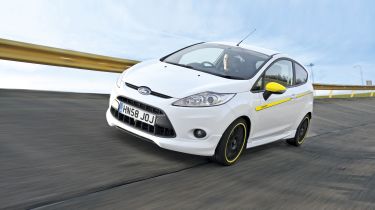Ford Fiesta Mountune
Can’t wait for a flagship Fiesta ST? Brit Firm may have the answer, as it turns up heat on supermini.

Once the cost of fitting has been taken into consideration, the Mountune Performance Package will add around £1,700 to the price of any 1.6-litre petrol-engined Fiesta. And although the tweaks are minor, they make the Ford sound and feel much sportier than it is in standard trim. If it’s a hot hatch you’re after, this is without a doubt the ultimate Fiesta.
Ford has a long and glorious history of building fast Fiestas, from the XR2i of the late Eighties to the previous-generation ST. The fact that the hottest version currently on sale is the 120bhp 1.6-litre Zetec S – a car that’s quick, but hardly the fastest in class – is seen by many as something of a disappointment, however. So, the blue oval has come to its senses, and is aiming to put things right!
Although it has yet to develop its own Fiesta hot hatch, Ford hopes to plug the gap in the line-up by commissioning British engineering firm Mountune to produce a successor to the ST. It’s based on the standard 1.6-litre machine, and adds a dramatic bodykit to a range of engine modifications to create a car that will deliver an impressive 140bhp at a howling 6,800rpm.
And it’s not only new owners who will benefit from Mountune’s efforts; drivers of existing 1.6-litre petrol models will be able to boost their Fiesta’s performance with a new package of tuning parts that are exactly the same as those fitted to the showroom-ready car. Available through Ford dealers next month, the tuning kit doesn’t affect the warranty, insurance group or road tax.
For fast Ford fans, all this sounds too good to be true. But can a package of aftermarket tweaks really improve the latest Fiesta enough to match the appeal of yesterday’s heroes? We got behind the wheel to find out.
Modifications
Visually, the Mountune Fiesta doesn’t look that different to a regular Zetec S model. It sits on the same sports suspension, and there are no major styling tweaks. The thinking is that the Fiesta is capable enough already, and adding visual modifications would make it expensive.
Instead, this model stands out thanks to its yellow mirror covers, a yellow go-faster stripe and black alloy wheels with bright yellow edging. If these are too boy racer for you, simply ignore them and specify the performance modifications to the engine.
Much of the car’s additional 20bhp comes from tweaks to the computer that controls the 1.6-litre unit.
This includes a more aggressive rev limiter, which cuts in abruptly at 6,800rpm, rather than the standard car’s softer 6,500rpm limit. As well as the ECU tweaks, there’s a new exhaust manifold and re-worked exhaust system, while an uprated air filter allows the engine to breathe more freely.
Although a gain of 20bhp doesn’t sound that dramatic, in a small model such as the Fiesta it’s sufficient to slash the 0-60mph sprint time by two seconds to 7.9 seconds. Coincidentally, that’s the same figure as the Fiesta ST managed to cover the benchmark dash.
However, where this car scores is with the noise it makes. A characterful engine note fills the cabin as the revs rise. It doesn’t become irritating, but offers a gratifyingly audible reward when you want to drive the Fiesta hard.
While Mountune has avoided changing the suspension, it has fitted Dunlop Sportmax tyres, which provide greater grip than the standard rubber. They’re a cost-effective way of further improving the already impressive Fiesta package, as they help the car turn in with even more precision, while aiding braking and giving more traction for acceleration.
All of this adds up to a hot Ford supermini that’s a worthy successor to the original Fiesta ST...
Rival: Vauxhall Corsa SRi
The Corsa can’t match the Ford’s supple ride and sharp handling. And while the SRi’s 7.6-second 0-60mph time is faster than the Mountune Fiesta’s, the Ford sounds a whole lot better and is much more fun to drive.




